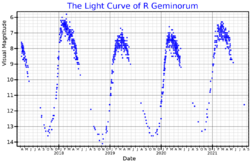Astronomy:R Geminorum
| Observation data Equinox J2000.0]] (ICRS) | |
|---|---|
| Constellation | Gemini |
| Right ascension | 07h 07m 21.271s[2] |
| Declination | +22° 42′ 12.75″[2] |
| Apparent magnitude (V) | 6.0 - 14.0[3] |
| Characteristics | |
| Evolutionary stage | AGB |
| Spectral type | S2,9e-S8,9e(Tc)[3] |
| Variable type | mira[3] |
| Astrometry | |
| Radial velocity (Rv) | −45.2[4] km/s |
| Proper motion (μ) | RA: −8.765[2] mas/yr Dec.: 0.665[2] mas/yr |
| Parallax (π) | 1.1795 ± 0.0960[2] mas |
| Distance | 2,800 ± 200 ly (850 ± 70 pc) |
| Details | |
| Radius | 431[5] R☉ |
| Luminosity | 5,500[5] L☉ |
| Temperature | 2,400[5] K |
| Other designations | |
| Database references | |
| SIMBAD | data |
R Geminorum (R Gem) is a Mira variable and technetium star in the constellation Gemini. It is located approximately 850 parsecs (2,800 ly) away.
R Geminorum pulsates with an average period of 369.9 days, varying by up to eight magnitudes at visual wavelengths.[3] When at maximum light its apparent visual magnitude is usually between 6 and 7, while at minimum light it is typically near magnitude 14.[7]
R Geminorum is one of the brightest known examples of an S-type star, a type that is similar to M-type star, but whose spectra shows zirconium oxide, yttrium oxide and technetium.[8] These exotic elements are formed in the star's core. Technetium has a half-life of just 4.2 million years, so it must have been brought up from the core relatively recently. R Gem has an unusual amount of it, even for an S-type star.[8]
References
- ↑ "Download Data". AAVSO. https://www.aavso.org/data-download.
- ↑ 2.0 2.1 2.2 2.3 2.4 Brown, A. G. A. (2021). "Gaia Early Data Release 3: Summary of the contents and survey properties". Astronomy & Astrophysics 649: A1. doi:10.1051/0004-6361/202039657. Bibcode: 2021A&A...649A...1G. Gaia EDR3 record for this source at VizieR.
- ↑ 3.0 3.1 3.2 3.3 Samus, N. N. et al. (2009). "VizieR Online Data Catalog: General Catalogue of Variable Stars (Samus+ 2007-2013)". VizieR On-line Data Catalog: B/GCVS. Originally Published in: 2009yCat....102025S 1: B/gcvs. Bibcode: 2009yCat....102025S.
- ↑ Gontcharov, G. A. (2006). "Pulkovo Compilation of Radial Velocities for 35 495 Hipparcos stars in a common system". Astronomy Letters 32 (11): 759–771. doi:10.1134/S1063773706110065. Bibcode: 2006AstL...32..759G.
- ↑ 5.0 5.1 5.2 Ramstedt, S.; Schöier, F. L.; Olofsson, H. (2009). "Circumstellar molecular line emission from S-type AGB stars: Mass-loss rates and SiO abundances". Astronomy & Astrophysics 499 (2): 515–527. doi:10.1051/0004-6361/200911730. Bibcode: 2009A&A...499..515R.
- ↑ "R Geminorum". SIMBAD Astronomical Database. Centre de Données astronomiques de Strasbourg. http://simbad.u-strasbg.fr/simbad/sim-id?Ident=R+gem&NbIdent=1&Radius=2&Radius.unit=arcmin&submit=submit+id. Retrieved 20 January 2014.
- ↑ "Light Curve Generator". American Association of Variable Star Observers. http://www.aavso.org/lcg/plot?auid=000-BBM-508&starname=R+GEM&lastdays=20000&start=&stop=2457071.22531&obscode=&obscode_symbol=2&obstotals=yes&calendar=calendar&forcetics=&grid=on&visual=on&uband=on&bband=on&v=on&pointsize=1&width=800&height=450&mag1=&mag2=&mean=&vmean=. Retrieved 17 February 2015.
- ↑ 8.0 8.1 MacRobert, Alan (January 2015). "Weird R Gem Climbs to Maximum". Sky & Telescope 129 (1): 51. Bibcode: 2015S&T...129a..51M.
 |


